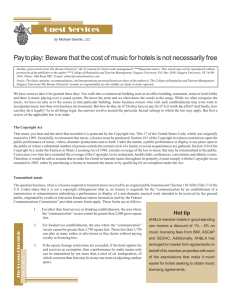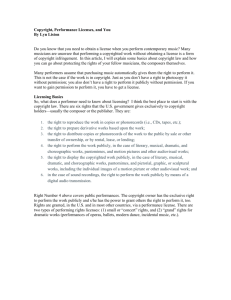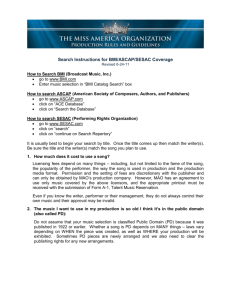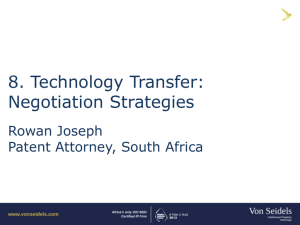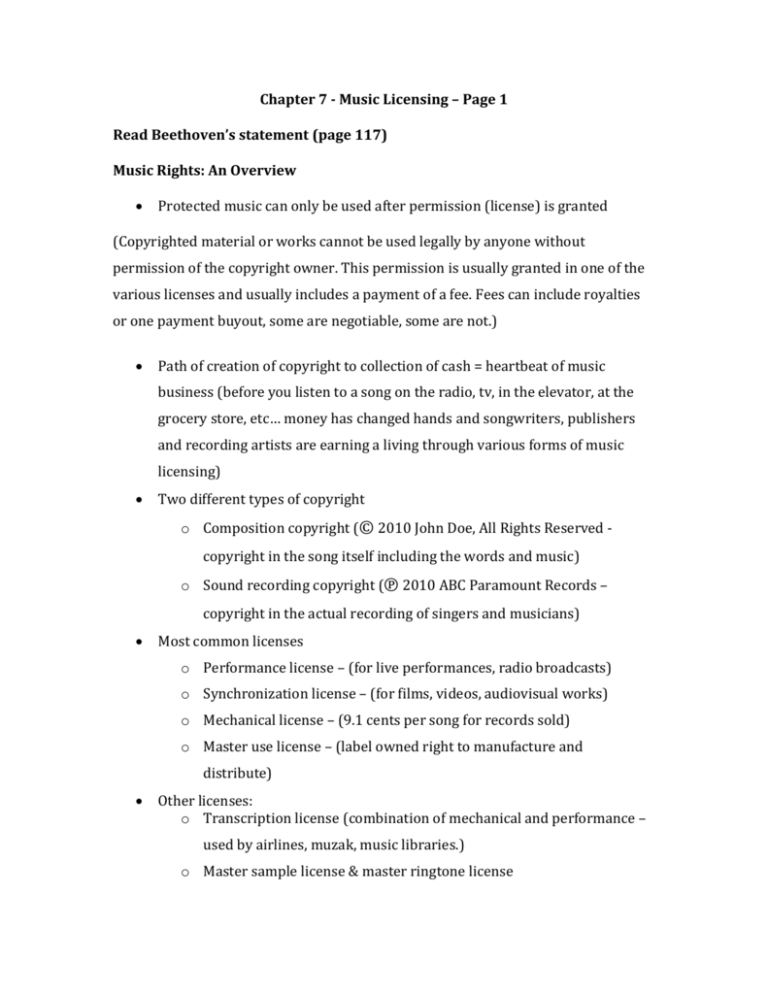
Chapter 7 - Music Licensing – Page 1
Read Beethoven’s statement (page 117)
Music Rights: An Overview
Protected music can only be used after permission (license) is granted
(Copyrighted material or works cannot be used legally by anyone without
permission of the copyright owner. This permission is usually granted in one of the
various licenses and usually includes a payment of a fee. Fees can include royalties
or one payment buyout, some are negotiable, some are not.)
Path of creation of copyright to collection of cash = heartbeat of music
business (before you listen to a song on the radio, tv, in the elevator, at the
grocery store, etc… money has changed hands and songwriters, publishers
and recording artists are earning a living through various forms of music
licensing)
Two different types of copyright
o Composition copyright (© 2010 John Doe, All Rights Reserved copyright in the song itself including the words and music)
o Sound recording copyright (℗ 2010 ABC Paramount Records –
copyright in the actual recording of singers and musicians)
Most common licenses
o Performance license – (for live performances, radio broadcasts)
o Synchronization license – (for films, videos, audiovisual works)
o Mechanical license – (9.1 cents per song for records sold)
o Master use license – (label owned right to manufacture and
distribute)
Other licenses:
o Transcription license (combination of mechanical and performance –
used by airlines, muzak, music libraries.)
o Master sample license & master ringtone license
Chapter 7 - Music Licensing – Page 2
o Statutory master-use performance license (rate set by Copyright
Royalty Board (CRB) applies to streaming downloads – 1st example
of sound recording owner receiving royalties for performance!
Look at table 7.1 on page 119
Performance Rights Organizations
Largest source of income is for performance licenses granting right to
perform work on radio TV or in live performances. Approx. 80 – 85% of
performance income comes from broadcasting with 10 – 15% non-broadcast
(concerts, clubs, symphonies, circuses, etc…
U.S. recording artists historically have not received performance royalties
PROs - ASCAP, BMI, and SESAC
o Issue licenses
o Collect and distribute royalties
o Issue blanket performance licenses (versus source licenses)
o Collect approximately $2 billion annually
Blanket License - “covers entire catalog usually for a year, (sometimes 5 years)
it’s a performance license used by broadcasters and night clubs, restaurants,
concert venues, etc... Some entertainment companies, mainly TV, feel it’s unfair to
pay for a blanket license when they use a small portion of the catalog and are
lobbying congress to be licensed at the source - direct from the copyright owner for
a negotiated fee. Some broadcasters consider the blanket licenses controlled by the
three performing rights organizations to be a form of monopoly.
Performance Licensing: The Nuts and Bolts – The PRO’s license performances,
distribute royalties to publishers and writers, distribute awards, lobby congress, sue
infringers, and promote music scholarship. They do not publish music (BMI did
early in it’s history) nor do they promote individual copyrights. They license radio
and TV stations, clubs, airlines, circuses, anywhere copyrighted music is performed
or reproduced, or broadcast.
Chapter 7 - Music Licensing – Page 3
ASCAP, BMI, and SESAC collect to 2 billion dollars annually including foreign and
domestic. ASCAP & BMI are non-profit and retain 17% to 19% of gross earnings to
cover overhead and distribute the rest to members and affiliates.
SESAC is a for-profit business and doesn’t have to publish financial records (except
to the IRS) but claims it’s royalties are equal to ASCAP & BMI.
Prospective licensees are contacted by reps or by mail and educated regarding
copyright law and then encouraged to negotiate a license. If they fail to do so and
continue using copyrighted works they are sued for infringement. Suits are usually
based on infringements of specific members for specific infringements and are
almost always won be the performing rights organization.
Clubs and bars are usually asked to sign a 1 year blanket license, Hotels and Motels a
5 year license. Factors considered in determining price are seating capacity,
whether admission is charged, weekly music budget, number of hours of musical
entertainment provided and can take into account the estimated gross income of
venue. With venues that have only occasional musical events, ASCAP, BMI, and
SESAC will look to the producer or promoter renting the venue.
Performing artists or their agents never pay performance royalties to anyone!
Keeping Track of the Music
PRO’s monitor marketplace data – use a variety of methods
o Review cue sheets and program logs of broadcasters
o Record some TV and radio broadcasts
o Censuses of performances transmitted by music services and online
streaming
o Use technology such as Broadcast Data System (BDS) or Mediaguide
o Clubs, hotels,skating rinks, etc… are too costly to monitor so
distribution is based on radio and tv play.
Chapter 7 - Music Licensing – Page 4
Income, Royalty Distribution
o Determined by the number and kind of performances
o All three PROs calculate and weight performances and resulting
royaties differently – Example: if a song is co-written by two
songwriters belonging to different PROs, their royalties would be
different on the same song
Note: TV and Radio performances generate the majority of performance royalty
income with only about 15% coming from all the non-broadcast areas.
Writers with widely performed works can earn royalties into six figures.
Foreign Collections
o Berne Convention - Major development in receiving foreign royalties
was US signing the Berne Convention, an international treaty dealing
with copyright issues. Under it’s rules, member countries treat
foreigners as nationals for copyright protection purposes.
o Foreign subpublishers - are extremely important for effective
monitoring and collection. For smaller companies not connected with
subpublishers, ASCAP, BMI & SESAC maintain reciprocal agreements
with similar licensing organizations abroad who collect performance
royalties for them. Most other countries have only one licensing
organization unlike the US so all three US PRO’s only have to deal with
one for each country.
Note: Currently there are over 60 foreign territories with reciprocal PROs.
Identifying songs that are re-recorded and re-titled in a foreign language is
sometimes difficult causing occasional lose of royaltees for the writer and publisher.
This situation is getting better with with more modern tracking and accounting
techniques.
Chapter 7 - Music Licensing – Page 5
Membership Options
Songwriters can affiliate with only one PRO! - Which PRO to join? Examine
all three as they apply to your particular situation, style of music, films, jingle
pop, rock, etc… Once deciding on one, stick with it because you can’t belong
to more than one and you can only receive royalties from one. If you give up
your membership in one to join another, you also give up your royalties. How
do you get around that?
Review of ASCAP – (Largest PRO - Non-Profit) Founded because of US
Copyright of 1909 (declared copyrighted works belong to their creator and
others wishing to perform them must get permission from the copyright
owner!)
ASCAP - First PRO - formed 1914 - had very difficult time at first because everyone
was accustomed to using music for free. Many years of educating music users, court
decisions favorable to copyright holders, and new legislation has resulted in music
licensing being well accepted and implemented. Some still need a little arm-twisting.
Income, Royalty Distribution
20% t0 25% of ASCAP’s income is from reciprocating foreign licensing
organizations. Half of the performance income is from TV stations and networks.
25% come from radio. Annual fees for most broadcasters are calculated based on a
small percentage of adjusted gross income.
Membership
Charter members included Victor Herbert, John Philip Sousa, Jerome Kern, George
M. Cohan and Irving Berlin. To become a member you must have at
least one song published and distributed, or commercially recorded, available on
rental, or performed in media licensed by ASCAP. (a nightclub performance would
work) Membership is free! - (writers was $10 per year and publishers was $60 members voted fees out)
Chapter 7 - Music Licensing – Page 6
ASCAP’s board is 12 writer members and 12 publisher members elected by the
membership. Many of the greatest names in American music have served on the
board.
Because of many complaints by music users over the years, claiming that music
licensing was unfair and monopolistic, the U.S. Department of Justice agreed to court
administered control of ASCAP with ASCAP’s consent. Legally called a consent
decree, it provides a court-appointed judge to supervise ASCAP’s affairs especially
regarding licensing music users and royalty payments to it’s members.
ASCAP bestows many annual awards in a variety of categories to it’s members. Since
1968, the Deems Taylor Award has gone to authors and publishers of outstanding
books on music. The second addition of the “Music Business Handbook” was
honored with the award in 1980. (We are using the 10th edition.)
Sampling, Accounting
Members must supply information such as what songs are in their catalog (and are
registered with ASCAP) and update that information so ASCAP knows how to
identify member works during thier sampling and monitoring of all broadcast media
and performance venues.
Methods of sampling - surveying
• Cue sheets - tv films and programs, theatrical films
• Random sampling of local commercial radio & TV airplay - plus cue sheets, TV
Guide and info from TV Data and Tribune Media Services. (TV Data & TMS
compile
listings of every program aired on every local US TV station)
• Census (complete count) of all performances on major TV networks plus cue
sheets and program logs and audio and video recording to check log accuracy
• Census or sampling of major cable networks - program guides & cue sheets (HBO)
• Sampling of wired services (Muzak), airlines, circuses, ice shows
• Sampling (smaller scale) of PBS, NPR and college radio airplay
ASCAP field offices will record local TV broadcasts of all stations signals that reach
the field office.
ASCAP randomly tapes radio broadcasts throughout the U.S. Tapes and logs are sent
to New York where staff of experts analyzes them to identify indiviidual
performances.
Weighting Performances
Chapter 7 - Music Licensing – Page 7
Formulas are used to calculate relative value, or weight, of sampled performances:
• Medium - local radio, national TV, major film, independent film
• Weight of station - determined by amount of blanket performance fee paid to
ASCAP
• Weight of TV network (number of stations carrying a performance and time of
day)
• Type of performance - feature, theme, background, bumper, etc.....
• Duration - for music underscoring a film
Broadcast Music Inc. (BMI)
BMI - originally 475 stockholders (US broadcasters) prospectus in 1930’s stated
stockholders could expect no dividends, none were ever paid! Formed in 1939, It’s
run by a president and CEO who are major stockholders. Like ASCAP, it operates
under a consent decree but with different set of constraints.
Membership
There are no “members” , there are writer and publilsher affiliates. No annual
charge for either. More or less the same requirements for writer members as ASCAP.
BMI states that publisher affiliation won’t be beneficial unless you have the ability
and financial resources to undertake broad-based exploitation of works. BMI also
requires publisher affiliates to satisfy reasonable standards of literacy and integrity.
One time $150 application fee and they won’t consider you as a publisher affiliate
until you are a writer member with several songs earning royalties. ASCAP, on the
other hand has no fees and only requires that you are about to acquire a work
that is already published.
BMI licensed lots of styles that were not being licensed by ASCAP such as jazz, R&B,
country, gospel and folk. 90% of the hits in the “Golden Age of Rock” were licensed
by BMI!
BMI offers awards to school composers, unknown writers and arts organizations to
promote membership (affiliation) and also offers some well known seminars such
as the Songwriters’ Workshops which instruct on the craft and on placement of
unpublished material, The Lehman Engel Musical Theater Workshop in LA, The Jazz
Composers’ Workshop in NY, the Film & Television Composers’ Workshop in LA and
many Music Business Workshops in cooperation with universities. BMI uses all of
the above activities as recruitment opportunities.
Sampling, Accounting
Very similar to ASCAP with some differences:
Chapter 7 - Music Licensing – Page 8
• To reduce the number of music users to deal with, BMI negotiates industry wide
rates with such groups as the American Hotel and Motel Association and the
American Symphony Orchestra League
• BMI uses a combination of sampling and census techniques including recording
hundreds of radio stations resulting in 4 million hours of radio broadcasting. All
data is combined and weighting formulas (similar to ASCAP but different) are used
to calculate royalty payments to affiliated writers and publishers.
Income, royalty distribution
BMI’s contract with writers and publishers does not list payment rates but BMI
publishes a “Royalty Information Booklet” with that information. Payments are
higher for songs surveyed on stations paying a higher license fee and lower for
stations paying a lower fee. Very different than ASCAP but still a form of “weighting”.
Performance royalties are distributed quarterly and pop concert and foreign
performance are paid twice annually. Classical performance royalties are
distributed once a year.
SESAC – (The second oldest PRO) originally known as the Society of European
Stage Authors and Composers - since the 1960’s known only as SESAC. Formed in
1930 as a for-profit company, not governed by consent decree, it’s the smallest of
the three. Claims it can respond to individual members needs better because of
smaller size and is more efficient because it’s run like a business for profit.
Sampling, Accounting, Income, Royalty Distribution
Recently, SESAC has become the technological leader among US PRO’s by being the
first to embrace state of the art tracking systems. In 1993, it formed a division called
SESAC Latina which formed an alliance with Broadcast Data Systems. That was so
successful that two years later they expanded BDS usage to include most other
major radio formats. (BDS “listens” to selected radio and TV stations 24/7 and
can identify any song in it’s database from it’s digital finger print.)
SESAC pays more for performances on large station than on small ones.
SESAC has reciprocal agreements with about 60 foreign PRO’s. Their performance
licenses are based on fixed fees instead of music user’s income.
Like ASCAP & BMI, they offer many workshops, seminars, and songwriter
showcases plus offering legal consultation for contracts and help in pairing potential
songwriting partners.
Chapter 7 - Music Licensing – Page 9
Sound Exchange – created in 2000 by Recording Industry Association of America
(RIAA) – became independent non-profit PRO in 2003
US Copyright Office has designated them as principal administrator of
of digital performance royalties (for royalty artists and owners of sound recording
copyrights). Current collections and distributions are relatively small compared to
other PROs but will become more significant in future!
Mechanical Licenses (In 1978 the statutory rate was 2.75 cents per song (under 5
minutes) or .5 cents per minute, whichever was greater. Current rate is 9.1 cents
(under 5 Min) or 1.75 cents per minute, whichever is greater.)
For recordings distributed commercially only for private use – (basically
commercial CDs the public purchases)
Negotiated mechanical license differs from statutory compulsory license
Besides the compulsory mechanical provided for by copyright law, with it’s inherent
statutory fee, another mechanical license is also allowed and much more used and
preferred in the music industry, the negotiated mechanical license. It differs from
the compulsory license in three ways:
o Royalty rate can be lower
o Royalty accountings are usually quarterly instead of monthly like the
compulsory
o Statutory requirement of “notice of intent” to record copyrighted work is
waived
The Harry Fox Agency, Inc.
Most publishers use the Harry Fox Agency to issue mechanical licenses. They tell
Fox what rate to charge (can’t be more than current statutory rate), fox negotiates
license, collects the royalties, keeps 6.75% service fee and forwards balance to
publisher who pays writer. Publishers not large enough to have foreign branch
offices will use Harry Fox for foreign licensing and royalty collection. Foreign
agencies charge Harry Fox 5 to 20%, Fox takes it’s 6.75% and forwards balance to
publisher.
Other alternatives for publishers are the American Mechanical Rights Agency
(AMRA) and SESAC who will both collect and distribute mechanical royalties for a
fee.
Chapter 7 - Music Licensing – Page 10
Synchronization Licenses
Music timed to synchronize with action on the screen
Three sources of film music:
o new music composed specifically for film – usually as a work for hire
(producer is considered author and doesn’t need any license)
o already copyrighted and published – new performance in film (needs 2
licenses – synch & performance (for US)
o already copyrighted and published – use of actual hit (or not) record –
(producer needs performance and synch license and also has to negotiate
“new use” licensing with the record label)
Synchronization license fees vary – (Fees for both the synch license and
performance license (which can be done in one document for one fee) will
depend on how broad the license is and whether the music will be
background, long, short, sung by star, sung by non-star, played
instrumentally, has already been a hit, how big, etc...)
o Producers can sometimes make a great deal financially because copyright
owners know having their work in a feature film is great exposure and
can lead to other revenue streams besides the license fees for the film.
European conditions
Theatrical motion picture producers in the US need to get two kinds of licenses, a
synchronization license (for music synched or time to screen action) and a
performance license which they usually go straight to the publisher for. The
performance license is needed in the US only because movie theaters don’t have
blanket licenses like radio and tv stations. Not needed overseas!
o The producer wants to get the most broad type of synch license:
all future media - film , TV , syndication, unlimited new use
world wide
long term - length of copyright is best
An important reason for producer to seek this type of license is so that the film
company can release it in any present or future market knowing all the rights are
Chapter 7 - Music Licensing – Page 11
licensed properly. One song not licensed properly could prevent proper release and
full exploitation of a film, the last thing a producer wants. He has to guarantee the
film company and the performance bond company in writing that all clearances are
in order or his current project and future career are in jeopardy.
TV Movie Rights
When film produced originally for TV, broad synch license to cover digital
downloads, streaming, foreign territories, etc… No performance license necessary
because most media have blanket performance licenses.
New use rights
If the producer wants to license an actual hit record then negotiations become even
more complicated and involve the record company, the AFM & AFTRA which will
require new use payments.
Cable Television Licenses (that pick up TV stations signals, boost them, and
deliver them to homes via cable)
The business of offering secondary transmissions of primary material (1976
Copyright Act defines cable television broadcasts as “secondary transmission
of primary material” )
Compulsory license issued by US Copyright Office
o Copyright Office administers copyright and distributes money to
copyright owners
o sets rates in conjunction with the Copyright Royalty Board (CRB)
Other Cable TV Licenses (TV station signals PLUS additional programming
like HBO, Showtime, etc…)
o Network agreements - Most cable TV operators are referred to as
multiple system operators (MSO’s)
o
They carry programming form a variety of sources. The PROs negotiate licenses
with networks such as HBO, Showtime, etc… that are not compulsory.
o Satellite Home Viewer Act of 1988 requires a compulsory license for
programs delivered via satellite.
Chapter 7 - Music Licensing – Page 12
Video Licenses
Not addressed in 1976 Copyright Act - MTV’s launch in early 1980’s made
videos and important part of record promotion and marketing. Videos
weren’t specifically covered in the 1976 Copyright Act.
Consensus - Entertainment lawyers and industry leaders formed a
consensus:
1. Videos (film or videotape) are classified as “audiovisual works” that
therefore require a synch license
2. Broadcasters showing videos to public must have a performance license
(usually covered by blanket license)
3. Video producers or manufacturers must pay publishers for the right to
reproduce the videos as cassettes or discs for home use. This is not
automatically considered a synch license although in newer contracts it is
often included.
Transcription Licenses
Music used by syndicated programs, background music companies, in-flight
entertainment, music library services
Require mechanical license and performance license (the two may be
negotiated together or separately but together they comprise the
transcription license
Negotiation are directly with publisher or HFA - jIn the case of film (in-flight
entertainment) a synch license is also required
Special Use Permits
Broadcast Commercials – can be big bucks – no set fees, Microsoft paid
millions to use the Rolling Stones “Start Me Up” License usually includes right
to alter lyrics.
Original music can be royalties or buy-out if license is for advertising
purposes only
Video (electronic) games – multi-billion dollar industry – great source of
publishing revenue – negotiations tied to length of usage, manufacturing run,
projected earnings – CLOUT – how bad does the manufacturer want the music!
Chapter 7 - Music Licensing – Page 13
Jukebox Licenses – Prior to 1978 no licensing necessary (jukeboxes considered
toys)
Performance license for nondramatic music
JLO blanket license – 1990 (JLO) Jukebox License Office – Negotiated with
ASCAP, BMI & SESAC with the latest agreement “Juke License Agreement” in
effect as of January 1, 2007. Current rate - $434.00 per year for one jukebox.
www.jukeboxlicense.com
Dramatic Music Rights
Compositions used in the context of a wider piece or in the telling of a larger
story - Broadway shows, Opera, TV Films. Also called Grand rights
Grand rights and small rights – small rights are everything else = nondramatic
ASCAP, BMI, SESAC - The PRO’s don’t administer or license grand rights.
They do administer performance rights if a single song is played on the radio
– not as part of the whole show, film, or whatever.
Broadway musical subsidiary rights – in the case that a successful Broadway
show’s producer does not send out a touring company, the rights to license a
touring company revert back to the authors
Dramatic performances require
o License
o Royalty payment
o Rental of show’s book, score, and parts

